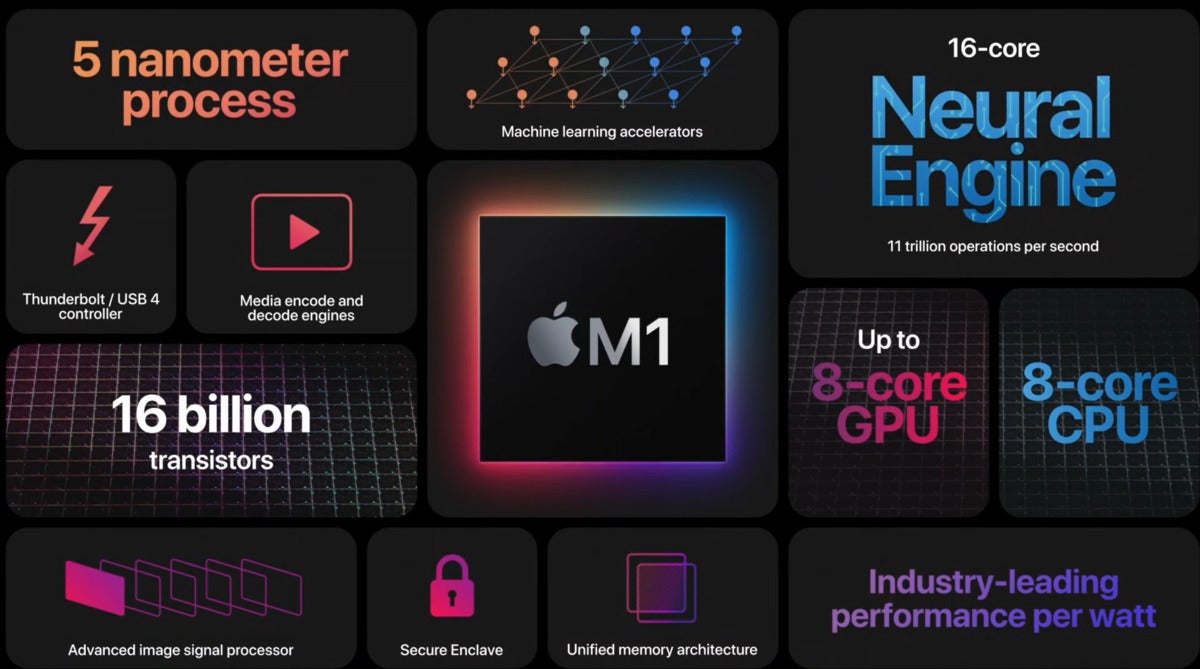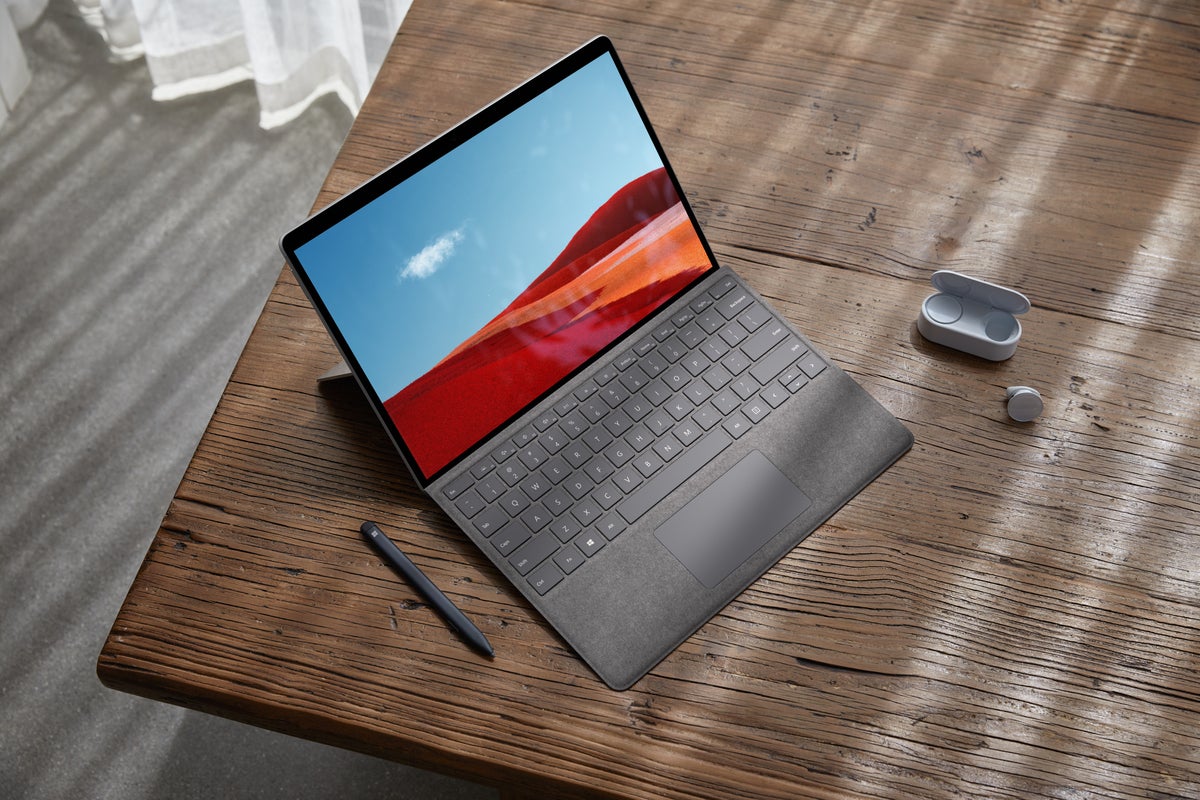Apple’s clout could give Windows on Arm a much-needed boost in the software department.
Microsoft
Today’s Best Tech Deals
Picked by PCWorld’s Editors
Top Deals On Great Products
Picked by Techconnect’s Editors
Apple’s announcement of the first Macs running on its own M1 Arm silicon just might be the boost that Windows on Arm needs to pass the finish line. Or so we can hope.
Granted, there was some tap-dancing during Apple’s Tuesday launch of a MacBook Air, MacBook Pro, and Mac mini that all use Apple’s first M1 processor, based on the Arm architecture. With eight cores inside (four cores for efficiency, four more for higher-power loads) we’re seeing big promises, including longer battery life (18 hours for the new 13-inch MacBook Air) and faster performance.
All of this should sound familiar to those who have watched Windows on Arm evolve over the past few years, especially as you start to drill down and look for hard numbers. What we can hope for, however, is that the combination of Apple’s clout, plus Microsoft’s existing development efforts, can finally make Windows on Arm a reality.
 Apple
AppleApple’s M1 chip.
Vague promises of performance
Apple’s claims first need to be knocked down a peg.
The company’s assertion that the M1-powered Air is “three times faster than the comparable Windows notebook in its class” is so vague as to be almost meaningless. Are these synthesized benchmarks? Code that Apple itself optimized, for the new M1 processors? What is the M1 being compared to: an Intel 10th-gen Ice Lake chip? Comet Lake? One of the new 11th-gen Tiger Lake processors?
 Apple
AppleWe’ve already been through this with the Windows-on-Arm camp, specifically Qualcomm’s own Snapdragon efforts. Beginning with the Asus NovaGo, the Snapdragon-based laptops absolutely delivered on one promise—truly “all-day” battery life—but fell short on performance claims that Arm chips could keep up with an Intel Core. Over time, Windows on Arm shifted (or was shoved) into a niche for always-connected PCs that could deliver average performance but great connectivity via their combination of Wi-Fi and cellular modems.
Color me skeptical, then, that Apple’s M1 can deliver comparable performance to Windows laptops. If it truly had the goods, we would already have seen head-to-head comparisons. We also noticed that Apple isn’t ready to give up on its Intel Core-powered MacBook Pros, especially in the 16-inch category.
Software matters
Where Apple excels is in the fusion of its hardware and software engineering efforts. Craig Federighi, the senior vice president of software engineering for Apple, claimed that Safari runs 1.5 times faster, and that Macs now instantly wake. “By designing the whole system together, hardware and software, we’re able to make the things you love about your Mac even better,” he said.
More important, however, is compatibility. Federighi announced plans for “Universal” apps—probably marketing-speak for an Apple App Store that could recognize what silicon a Mac is running and download the appropriate software binary. Note, too, that Apple’s software ecosystem is smaller and more tightly focused, with greater emphasis on its own apps than you see in the looser, broader Windows app ecosystem.
 JD Sartain / IDG
JD Sartain / IDGPhotoshop won’t be available as an Apple “universal” app until next yext year.
Apple’s tap-dancing a bit here again. Flagship applications like Adobe Photoshop won’t be available in a “universal” app format until next year, Federighi said. Notable omissions like that could relegate the MacBook Pro with M1 to ‘curiosity’ status for now.
This is nevetheless an area where Apple’s momentum could show Arm-powered PCs a way forward, whatever operating system they run. That’s because for M1 Macs, Apple’s Rosetta emulation technology steps in when native code isn’t available. On the Windows side, Arm chips can run 32-and 64-bit apps coded for Arm, and 32-bit apps coded for X86 on Windows—but they can’t yet run the most common 64-bit X86 apps that other PCs do. That’s supposed to be rectified this month—but only for Windows Insiders, and not for currently shipping PCs.
It’s time to make Windows on Arm a reality
Windows on Arm has a had a few years’ head start, but it’s still struggling to find its place. Even Microsoft’s own attempt, the Surface Pro X running on a Microsoft-designed Qualcomm SQ1 chip, launched without a prayer of 64-bit X86 app compatibility. Apple’s late to the party, but it’s taken its time, dressed appropriately, and presented a more cohesive vision to its customers.
Apple’s clout could help a lot, too. Developers who commit to coding for Apple on Arm may more easily justify developing for Windows on Arm as well.
X86 processors won’t go away, but Apple’s jump to the Arm camp clearly has Intel worried: “We believe Intel-powered PCs—like those based on 11th Gen Intel Core mobile processors—provide global customers the best experience in the areas they value most, as well as the most open platform for developers, both today and into the future,” Intel said in a statement released today.
 Microsoft
MicrosoftThe subtext? Arm now matters.
Now, it’s time for Microsoft to release its own 64-bit interpreter for Arm processors into the Windows Insider channel, and for PC makers once again to take a hard look at which platforms they support. Windows on Arm’s connectivity argument doesn’t make as much sense during a pandemic as it does in a world where people travel freely and connect wherever they’d like. But the vision remains viable, and Apple may help it get there.
Note: When you purchase something after clicking links in our articles, we may earn a small commission. Read our affiliate link policy for more details.
As PCWorld’s senior editor, Mark focuses on Microsoft news and chip technology, among other beats.


